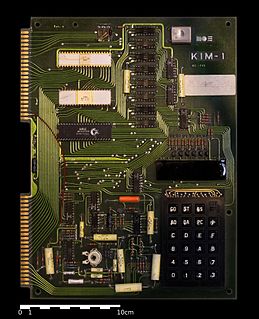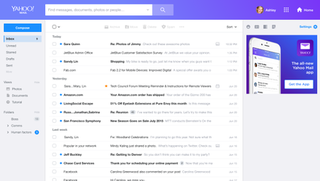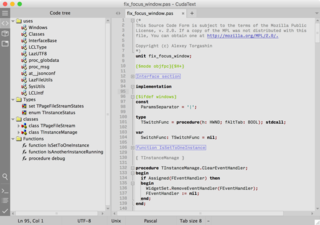Related Research Articles

HexChat is an Internet Relay Chat client, forked from XChat. It has a choice of a tabbed document interface or tree interface, support for multiple servers, and numerous configuration options. Both command-line and graphical versions were available.
An autonomous robot, also known as simply an autorobot or autobot, is a robot that performs behaviors or tasks with a high degree of autonomy. Autonomous robotics is usually considered to be a subfield of artificial intelligence, robotics, and information engineering. Early versions were proposed and demonstrated by author/inventor David L. Heiserman.

GNU Octave is software featuring a high-level programming language, primarily intended for numerical computations. Octave helps in solving linear and nonlinear problems numerically, and for performing other numerical experiments using a language that is mostly compatible with MATLAB. It may also be used as a batch-oriented language. Since it is part of the GNU Project, it is free software under the terms of the GNU General Public License.

The KIM-1, short for Keyboard Input Monitor, is a small 6502-based single-board computer developed and produced by MOS Technology, Inc. and launched in 1976. It was very successful in that period, due to its low price and easy-access expandability.
The robots exclusion standard, also known as the robots exclusion protocol or simply robots.txt, is a standard used by websites to communicate with web crawlers and other web robots. The standard specifies how to inform the web robot about which areas of the website should not be processed or scanned. Robots are often used by search engines to categorize websites. Not all robots cooperate with the standard; email harvesters, spambots, malware and robots that scan for security vulnerabilities may even start with the portions of the website where they have been told to stay out. The standard can be used in conjunction with Sitemaps, a robot inclusion standard for websites.

David Neil Laurence Levy is an English International Master of chess and a businessman. He is noted for his involvement with computer chess and artificial intelligence, and as the founder of the Computer Olympiads and the Mind Sports Olympiads. He has written more than 40 books on chess and computers.

Yahoo! Mail is an email service launched on October 8, 1997 by the American company Yahoo!, now a subsidiary of Verizon. It offers four different email plans: three for personal use and another for businesses. As of January 2020, Yahoo! Mail had 225 million users.

Fast Light Toolkit is a cross-platform widget library for graphical user interfaces (GUIs), developed by Bill Spitzak and others. Made to accommodate 3D graphics programming, it has an interface to OpenGL, but it is also suitable for general GUI programming.
This article provides basic comparisons for notable text editors. More feature details for text editors are available from the Category of text editor features and from the individual products' articles. This article may not be up-to-date or necessarily all-inclusive.
Mozilla Firefox has features that allow it to be distinguished from other web browsers, such as Chrome and Internet Explorer.
Cromemco was a Mountain View, California microcomputer company known for its high-end Z80-based S-100 bus computers and peripherals in the early days of the personal computer revolution.

Omron Adept Technology, Inc. is a multinational corporation with headquarters in Pleasanton, California. The company focuses on industrial automation and robotics, including software and vision guidance. Adept has offices throughout the United States as well as in Dortmund, Germany, Paris, France, and Singapore. Adept was acquired by Omron in October 2015.
Natural-language programming (NLP) is an ontology-assisted way of programming in terms of natural-language sentences, e.g. English. A structured document with Content, sections and subsections for explanations of sentences forms a NLP document, which is actually a computer program. Natural languages and natural-language user interfaces include Inform 7, a natural programming language for making interactive fiction, Shakespeare, an esoteric natural programming language in the style of the plays of William Shakespeare, and Wolfram Alpha, a computational knowledge engine, using natural-language input. Some methods for program synthesis are based on natural-language programming.
Google Chrome is a cross-platform web browser developed by Google. It was first released in 2008 for Microsoft Windows, and was later ported to Linux, macOS, iOS, and Android where it is the default browser built into the OS. The browser is also the main component of Chrome OS, where it serves as the platform for web applications.
C/MRI is a set of electronic modules that allow a computer to monitor and control real world devices, including those used in conjunction with model railroads.
An Internet Explorer shell is any computer program that uses the Internet Explorer layout engine, known as MSHTML. This engine is closed-source, but Microsoft has exposed an application programming interface (API) that permits the developers to instantiate either MSHTML or a full-fledged chromeless Internet Explorer within the graphical user interface of their software.

Snap! is a free, block-based educational graphical programming language and online community aimed at students to explore, create and re-mix interactive animations, games, stories, and more, while learning about mathematical and computational ideas. While inspired by Scratch, Snap! has many advanced features. The Snap! editor, and programs created in it, are web applications that run in the browser without requiring installation.

Ebot is a microcontroller unit that is based on open source technology, by two Kuwaiti innovators. Its part of a Prototyping platform called Ebot innovation platform to allow fast and easy prototyping. The platform has received many national and international prizes.

CudaText, from Bosnian-Croatian-Montenegrin-Serbian čuda, is a free open source cross-platform native GUI text and source code editor. CudaText supersedes its predecessor SynWrite, which is not actively developed anymore.

The Artie 3000 is a toy robot system made by Educational Insights.
References
- 1 2 Prendergast, Dan; Slade, Bill; Winkless, Nelson (January 1984). "A General-Purpose Robot Control Language". BYTE. p. 122. Retrieved 20 January 2015.
- ↑ Ciraolo, Michael. "Robot Update- Latest robot-Atari interface news". www.atarimagazines.com.
- ↑ "RB5X Robot - The Old Robot's Web Site". www.theoldrobots.com.
- ↑ Heiserman, David (1976). Build Your Own Working Robot. TAB Books. ISBN 0830668411.
- ↑ Heiserman, David L (1979). How to Build Your Own Self-Programming Robot. TAB Books. ISBN 0830612416.
- ↑ Heiserman, David L (1981). Robot Intelligence with Experiments . TAB Books. ISBN 0830696857.